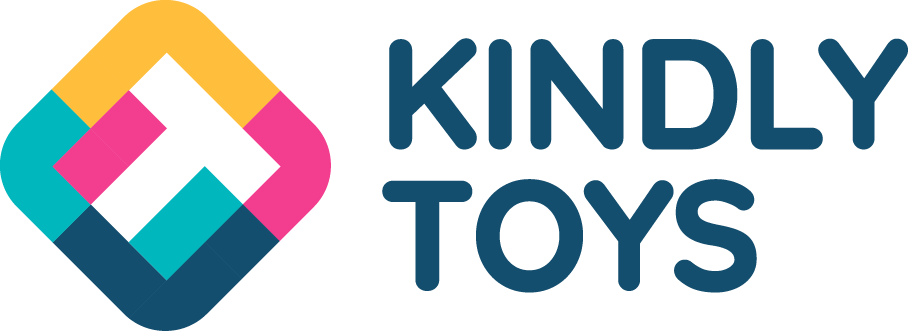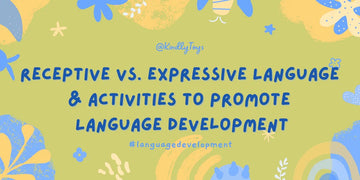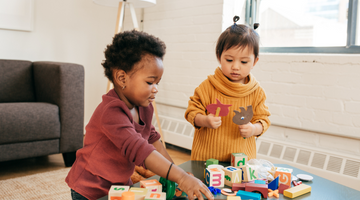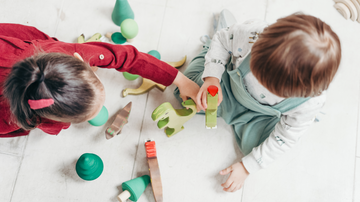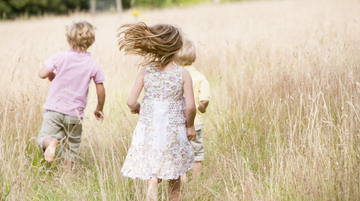Language development is an important area of development in children, as well as a vital part of a child’s communication in the early years. In the previous blog post, we’ve covered the definition of communication development, the different components of speech & language development, and lastly the stages of language development in children.
In today’s blog post, we’re gonna take a look at the difference between receptive language and expressive language, as well as some language development activities for children.

Source: Children playing on grass image by pressfoto on Freepik
Receptive Language vs. Expressive Language
Language is divided into two main sections: expressive and receptive language. So what do they actually mean?
Receptive Language
What is it?
Receptive language is the understanding of information provided in various forms such as sounds and words, movement and gestures, and signs and symbols. Typically developed first and faster, our receptive language vocabulary is generally larger than that of our expressive language.
Receptive Language Skills
- Understanding words, sentences and language concepts: Ability to comprehend vocabulary and sentences that form a conversation or story; quality/ quantity concepts such as big - small, left - right, etc.
- Following directions: Simple and multi-step directions or commands like “Put away your toys” or “Pass daddy the ball”
- Listening to and answering comprehension questions, stories and conversational information: Ability to listen to and interpret information in the forms of questions, stories or conversations; Ability to understand symbols and make predictions based on pictures or stories.
Expressive Language
What is it?
Expressive language is the ability to communicate our thoughts and feelings through words, gestures, signs, and symbols. When discussing expressive language, talking is the main form of communication people think about. Besides talking, other types of communication methods above are just as effective and essential in everyday life. Some examples include writing, sign language and pictures.
Expressive Language Skills
- Vocabulary: Ability to use words we know in everyday life
- Grammar: Ability to use the correct grammar form, such as using past tense to describe a past event, or future tense for predictions and forecasts
- Sentence Structure: Ability to put words in the right order to make sense
Activities to promote language development
Storytelling
Storytelling is in fact one of the best language development activities for preschoolers. There are several methods to create storytelling activities, but they all follow the same principle - Get your child to talk and expand their language skills by encouraging them to engage with and tell or retell stories, which will benefit children’s receptive, as well as expressive communication skills.
There are various reading activities parents and children can do together. Parents can read to their children traditionally at bed time, or try using interactive photo books and let children make up their own stories. Parents should also encourage children to find, identify things and recap what is happening in the story. Asking them questions about the story can also help boost their comprehension skills.
Lastly, it’s always better to start early. Make reading a part of your child’s daily routine or to foster their love of reading and promote their language skills.
Puzzles
This is another fantastic way to promote children’s receptive language skills, as well as fine motor skills. The key is to engage in conversation while putting together the puzzle. For example, you can ask them "Find the bear." and "What sound does the bear make?" or “What color is the bear?”. You can expand the conversation from then on, asking other questions about the bear or about other animals on the farm. Keep the conversation going as long as your child is engaged and enjoying themselves.

Music Activities
There are a wide range of music activities that children and parents can engage in to practice language skills, and also to have a good time. Most children love singing, dancing, and moving to the music, which is a great practice for their gross motor skills too. And through memorizing and repeating the lyrics, they can further improve their vocabulary.
Some songs or rhymes parents can try out are:
- “Happy And You Know It”
- "Humpty Dumpty"
- "Wheels On The Bus"
- "Twinkle, Twinkle Little Star"
- "Row, Row Row Your Boat"
- "5 Little Monkeys Jumping On The Bed"
Imaginative Play
Imaginative or Pretend Play can be considered one of the best activities for children’s language, as well as cognitive development. When they are allowed the freedom to create their own fantasy world and act in it, they focus harder and develop more complex, expressive language skills. This activity will also boost your child’s imagination and creativity, as they have to come up with a story on their own.
Parents can help their children by encouraging them to elaborate their story, asking questions such as "What’s going to happen next?" or "What are the princess’s favorite hobbies?". These open - ended questions will help build the sequence of events and storyline, helping your child develop their language skills and confidence.
Everyday play
One great thing about language is that it can be practiced wherever and whenever, regardless of activity. Language is all around us, and can be incorporated in everyday play.
During play, parents can try using various vocabulary such as "over," "under," "top” or “running”, “hopping” or “bouncing”. Another fun, everyday activity parents can try out is cooking. Get your children to help with washing and naming the vegetables, or taking them through the steps of a recipe. This will also be a great boost for your child’s language development.
And the most important note, children should be allowed to take the lead and be creative in their chosen activity. Once their imagination starts flowing and they are engaged, not only language but their other areas of development will benefit too.
